Report: Analysis of Smart Mobile Phone Usage in Australia, 2018
VerifiedAdded on 2021/05/31
|5
|2150
|93
Report
AI Summary
This report presents an analysis of smart mobile phone usage in Australia, addressing key questions posed by the Chief Data Analyst. The analysis covers the average monthly expenditure on mobile phones, exploring variations and central tendencies. It examines the relationship between monthly bills and lifestyle factors across different demographic categories, utilizing ANOVA tests to assess statistical significance. The report further delves into mobile phone affordability, comparing spending patterns across various demographics, including gender, geographic locations, and lifestyle choices such as tablet ownership, payment plan types, and entertainment preferences. The analysis also explores the proportion of Australians using their phones for work-related activities and payment methods, comparing the usage between different groups. Finally, the report examines the relationship between monthly phone bills and factors like the number of calls, SMS messages, and data allowance, providing a regression model and concluding with recommendations on appropriate sample sizes for future studies.
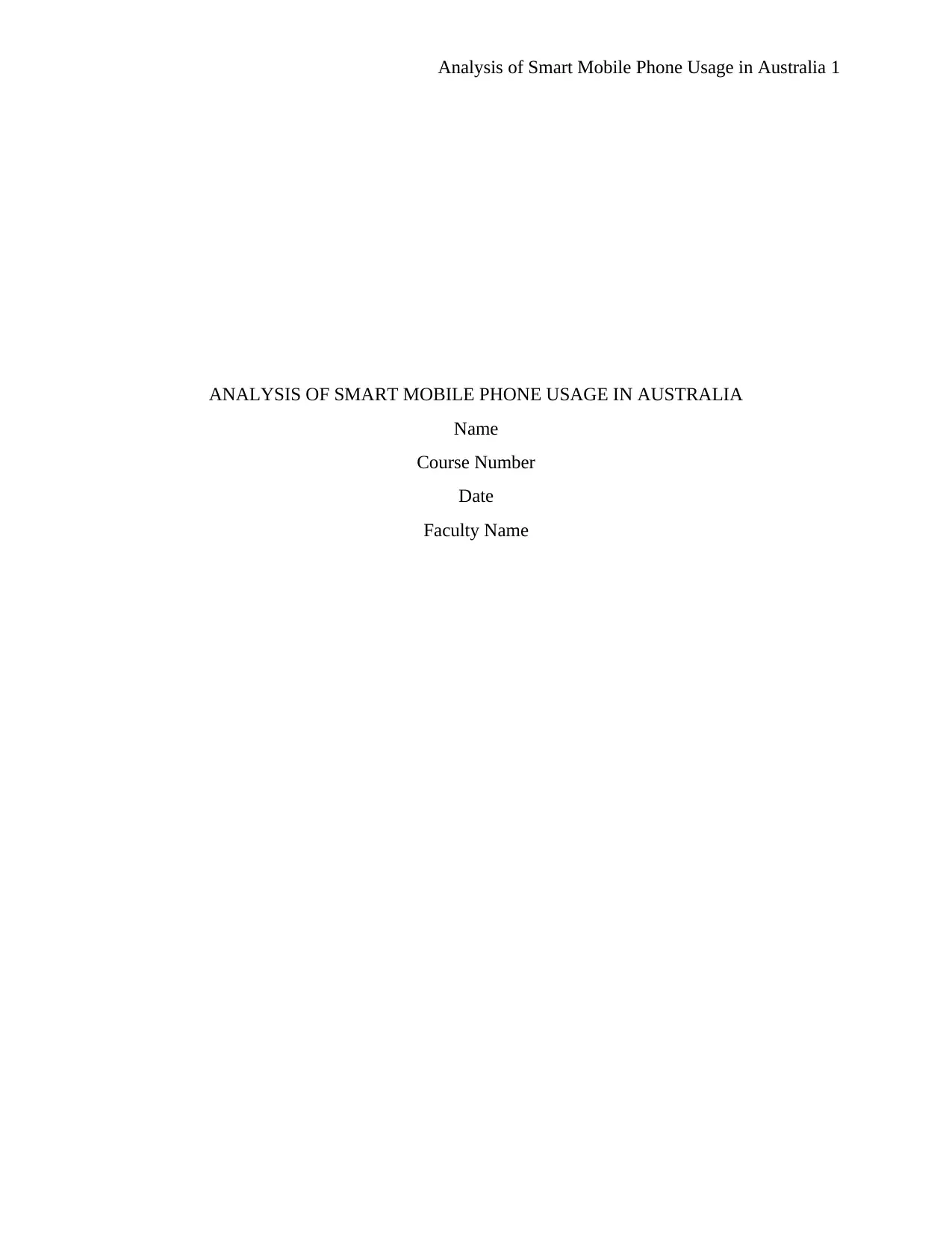
Analysis of Smart Mobile Phone Usage in Australia 1
ANALYSIS OF SMART MOBILE PHONE USAGE IN AUSTRALIA
Name
Course Number
Date
Faculty Name
ANALYSIS OF SMART MOBILE PHONE USAGE IN AUSTRALIA
Name
Course Number
Date
Faculty Name
Paraphrase This Document
Need a fresh take? Get an instant paraphrase of this document with our AI Paraphraser
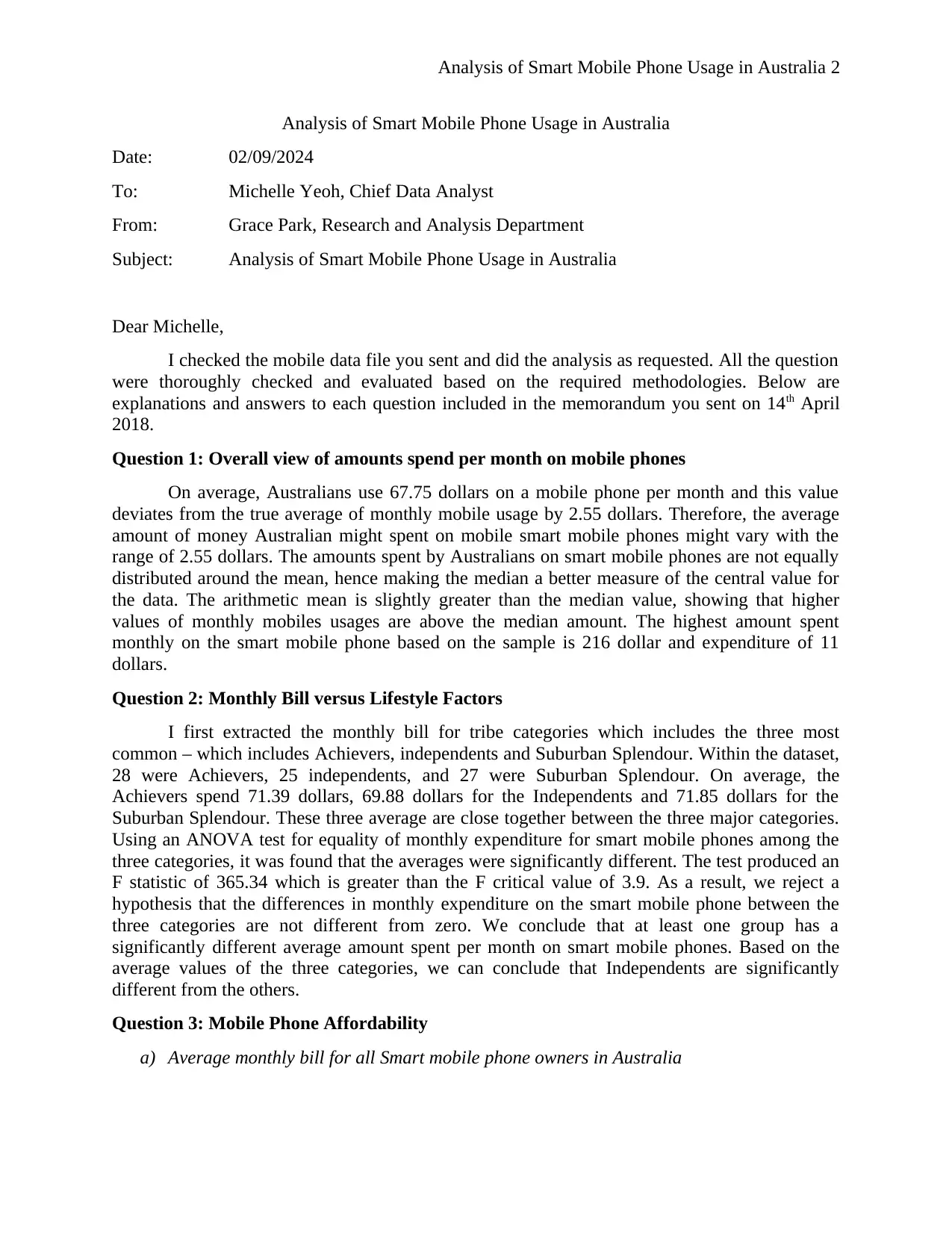
Analysis of Smart Mobile Phone Usage in Australia 2
Analysis of Smart Mobile Phone Usage in Australia
Date: 02/09/2024
To: Michelle Yeoh, Chief Data Analyst
From: Grace Park, Research and Analysis Department
Subject: Analysis of Smart Mobile Phone Usage in Australia
Dear Michelle,
I checked the mobile data file you sent and did the analysis as requested. All the question
were thoroughly checked and evaluated based on the required methodologies. Below are
explanations and answers to each question included in the memorandum you sent on 14th April
2018.
Question 1: Overall view of amounts spend per month on mobile phones
On average, Australians use 67.75 dollars on a mobile phone per month and this value
deviates from the true average of monthly mobile usage by 2.55 dollars. Therefore, the average
amount of money Australian might spent on mobile smart mobile phones might vary with the
range of 2.55 dollars. The amounts spent by Australians on smart mobile phones are not equally
distributed around the mean, hence making the median a better measure of the central value for
the data. The arithmetic mean is slightly greater than the median value, showing that higher
values of monthly mobiles usages are above the median amount. The highest amount spent
monthly on the smart mobile phone based on the sample is 216 dollar and expenditure of 11
dollars.
Question 2: Monthly Bill versus Lifestyle Factors
I first extracted the monthly bill for tribe categories which includes the three most
common – which includes Achievers, independents and Suburban Splendour. Within the dataset,
28 were Achievers, 25 independents, and 27 were Suburban Splendour. On average, the
Achievers spend 71.39 dollars, 69.88 dollars for the Independents and 71.85 dollars for the
Suburban Splendour. These three average are close together between the three major categories.
Using an ANOVA test for equality of monthly expenditure for smart mobile phones among the
three categories, it was found that the averages were significantly different. The test produced an
F statistic of 365.34 which is greater than the F critical value of 3.9. As a result, we reject a
hypothesis that the differences in monthly expenditure on the smart mobile phone between the
three categories are not different from zero. We conclude that at least one group has a
significantly different average amount spent per month on smart mobile phones. Based on the
average values of the three categories, we can conclude that Independents are significantly
different from the others.
Question 3: Mobile Phone Affordability
a) Average monthly bill for all Smart mobile phone owners in Australia
Analysis of Smart Mobile Phone Usage in Australia
Date: 02/09/2024
To: Michelle Yeoh, Chief Data Analyst
From: Grace Park, Research and Analysis Department
Subject: Analysis of Smart Mobile Phone Usage in Australia
Dear Michelle,
I checked the mobile data file you sent and did the analysis as requested. All the question
were thoroughly checked and evaluated based on the required methodologies. Below are
explanations and answers to each question included in the memorandum you sent on 14th April
2018.
Question 1: Overall view of amounts spend per month on mobile phones
On average, Australians use 67.75 dollars on a mobile phone per month and this value
deviates from the true average of monthly mobile usage by 2.55 dollars. Therefore, the average
amount of money Australian might spent on mobile smart mobile phones might vary with the
range of 2.55 dollars. The amounts spent by Australians on smart mobile phones are not equally
distributed around the mean, hence making the median a better measure of the central value for
the data. The arithmetic mean is slightly greater than the median value, showing that higher
values of monthly mobiles usages are above the median amount. The highest amount spent
monthly on the smart mobile phone based on the sample is 216 dollar and expenditure of 11
dollars.
Question 2: Monthly Bill versus Lifestyle Factors
I first extracted the monthly bill for tribe categories which includes the three most
common – which includes Achievers, independents and Suburban Splendour. Within the dataset,
28 were Achievers, 25 independents, and 27 were Suburban Splendour. On average, the
Achievers spend 71.39 dollars, 69.88 dollars for the Independents and 71.85 dollars for the
Suburban Splendour. These three average are close together between the three major categories.
Using an ANOVA test for equality of monthly expenditure for smart mobile phones among the
three categories, it was found that the averages were significantly different. The test produced an
F statistic of 365.34 which is greater than the F critical value of 3.9. As a result, we reject a
hypothesis that the differences in monthly expenditure on the smart mobile phone between the
three categories are not different from zero. We conclude that at least one group has a
significantly different average amount spent per month on smart mobile phones. Based on the
average values of the three categories, we can conclude that Independents are significantly
different from the others.
Question 3: Mobile Phone Affordability
a) Average monthly bill for all Smart mobile phone owners in Australia
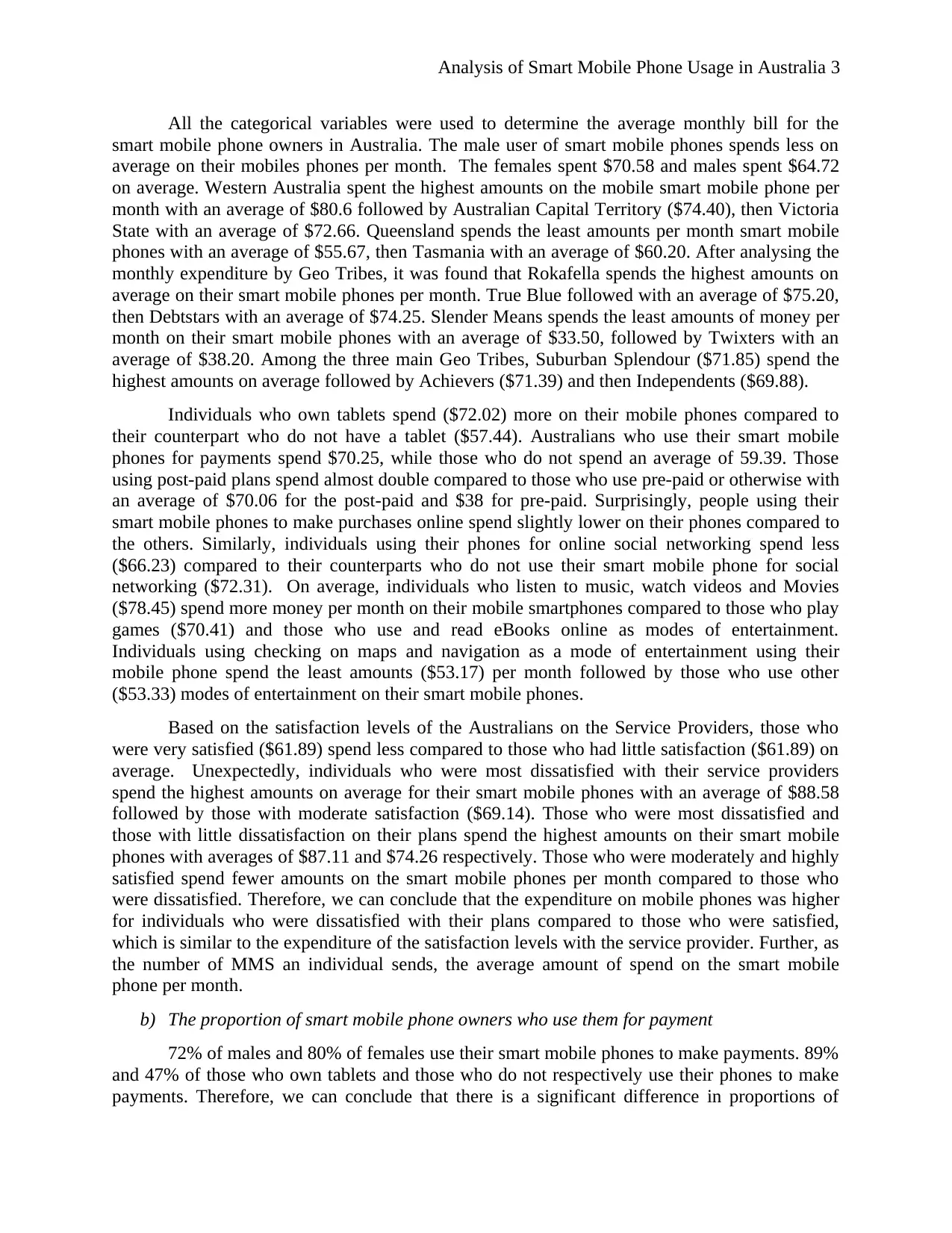
Analysis of Smart Mobile Phone Usage in Australia 3
All the categorical variables were used to determine the average monthly bill for the
smart mobile phone owners in Australia. The male user of smart mobile phones spends less on
average on their mobiles phones per month. The females spent $70.58 and males spent $64.72
on average. Western Australia spent the highest amounts on the mobile smart mobile phone per
month with an average of $80.6 followed by Australian Capital Territory ($74.40), then Victoria
State with an average of $72.66. Queensland spends the least amounts per month smart mobile
phones with an average of $55.67, then Tasmania with an average of $60.20. After analysing the
monthly expenditure by Geo Tribes, it was found that Rokafella spends the highest amounts on
average on their smart mobile phones per month. True Blue followed with an average of $75.20,
then Debtstars with an average of $74.25. Slender Means spends the least amounts of money per
month on their smart mobile phones with an average of $33.50, followed by Twixters with an
average of $38.20. Among the three main Geo Tribes, Suburban Splendour ($71.85) spend the
highest amounts on average followed by Achievers ($71.39) and then Independents ($69.88).
Individuals who own tablets spend ($72.02) more on their mobile phones compared to
their counterpart who do not have a tablet ($57.44). Australians who use their smart mobile
phones for payments spend $70.25, while those who do not spend an average of 59.39. Those
using post-paid plans spend almost double compared to those who use pre-paid or otherwise with
an average of $70.06 for the post-paid and $38 for pre-paid. Surprisingly, people using their
smart mobile phones to make purchases online spend slightly lower on their phones compared to
the others. Similarly, individuals using their phones for online social networking spend less
($66.23) compared to their counterparts who do not use their smart mobile phone for social
networking ($72.31). On average, individuals who listen to music, watch videos and Movies
($78.45) spend more money per month on their mobile smartphones compared to those who play
games ($70.41) and those who use and read eBooks online as modes of entertainment.
Individuals using checking on maps and navigation as a mode of entertainment using their
mobile phone spend the least amounts ($53.17) per month followed by those who use other
($53.33) modes of entertainment on their smart mobile phones.
Based on the satisfaction levels of the Australians on the Service Providers, those who
were very satisfied ($61.89) spend less compared to those who had little satisfaction ($61.89) on
average. Unexpectedly, individuals who were most dissatisfied with their service providers
spend the highest amounts on average for their smart mobile phones with an average of $88.58
followed by those with moderate satisfaction ($69.14). Those who were most dissatisfied and
those with little dissatisfaction on their plans spend the highest amounts on their smart mobile
phones with averages of $87.11 and $74.26 respectively. Those who were moderately and highly
satisfied spend fewer amounts on the smart mobile phones per month compared to those who
were dissatisfied. Therefore, we can conclude that the expenditure on mobile phones was higher
for individuals who were dissatisfied with their plans compared to those who were satisfied,
which is similar to the expenditure of the satisfaction levels with the service provider. Further, as
the number of MMS an individual sends, the average amount of spend on the smart mobile
phone per month.
b) The proportion of smart mobile phone owners who use them for payment
72% of males and 80% of females use their smart mobile phones to make payments. 89%
and 47% of those who own tablets and those who do not respectively use their phones to make
payments. Therefore, we can conclude that there is a significant difference in proportions of
All the categorical variables were used to determine the average monthly bill for the
smart mobile phone owners in Australia. The male user of smart mobile phones spends less on
average on their mobiles phones per month. The females spent $70.58 and males spent $64.72
on average. Western Australia spent the highest amounts on the mobile smart mobile phone per
month with an average of $80.6 followed by Australian Capital Territory ($74.40), then Victoria
State with an average of $72.66. Queensland spends the least amounts per month smart mobile
phones with an average of $55.67, then Tasmania with an average of $60.20. After analysing the
monthly expenditure by Geo Tribes, it was found that Rokafella spends the highest amounts on
average on their smart mobile phones per month. True Blue followed with an average of $75.20,
then Debtstars with an average of $74.25. Slender Means spends the least amounts of money per
month on their smart mobile phones with an average of $33.50, followed by Twixters with an
average of $38.20. Among the three main Geo Tribes, Suburban Splendour ($71.85) spend the
highest amounts on average followed by Achievers ($71.39) and then Independents ($69.88).
Individuals who own tablets spend ($72.02) more on their mobile phones compared to
their counterpart who do not have a tablet ($57.44). Australians who use their smart mobile
phones for payments spend $70.25, while those who do not spend an average of 59.39. Those
using post-paid plans spend almost double compared to those who use pre-paid or otherwise with
an average of $70.06 for the post-paid and $38 for pre-paid. Surprisingly, people using their
smart mobile phones to make purchases online spend slightly lower on their phones compared to
the others. Similarly, individuals using their phones for online social networking spend less
($66.23) compared to their counterparts who do not use their smart mobile phone for social
networking ($72.31). On average, individuals who listen to music, watch videos and Movies
($78.45) spend more money per month on their mobile smartphones compared to those who play
games ($70.41) and those who use and read eBooks online as modes of entertainment.
Individuals using checking on maps and navigation as a mode of entertainment using their
mobile phone spend the least amounts ($53.17) per month followed by those who use other
($53.33) modes of entertainment on their smart mobile phones.
Based on the satisfaction levels of the Australians on the Service Providers, those who
were very satisfied ($61.89) spend less compared to those who had little satisfaction ($61.89) on
average. Unexpectedly, individuals who were most dissatisfied with their service providers
spend the highest amounts on average for their smart mobile phones with an average of $88.58
followed by those with moderate satisfaction ($69.14). Those who were most dissatisfied and
those with little dissatisfaction on their plans spend the highest amounts on their smart mobile
phones with averages of $87.11 and $74.26 respectively. Those who were moderately and highly
satisfied spend fewer amounts on the smart mobile phones per month compared to those who
were dissatisfied. Therefore, we can conclude that the expenditure on mobile phones was higher
for individuals who were dissatisfied with their plans compared to those who were satisfied,
which is similar to the expenditure of the satisfaction levels with the service provider. Further, as
the number of MMS an individual sends, the average amount of spend on the smart mobile
phone per month.
b) The proportion of smart mobile phone owners who use them for payment
72% of males and 80% of females use their smart mobile phones to make payments. 89%
and 47% of those who own tablets and those who do not respectively use their phones to make
payments. Therefore, we can conclude that there is a significant difference in proportions of
⊘ This is a preview!⊘
Do you want full access?
Subscribe today to unlock all pages.

Trusted by 1+ million students worldwide
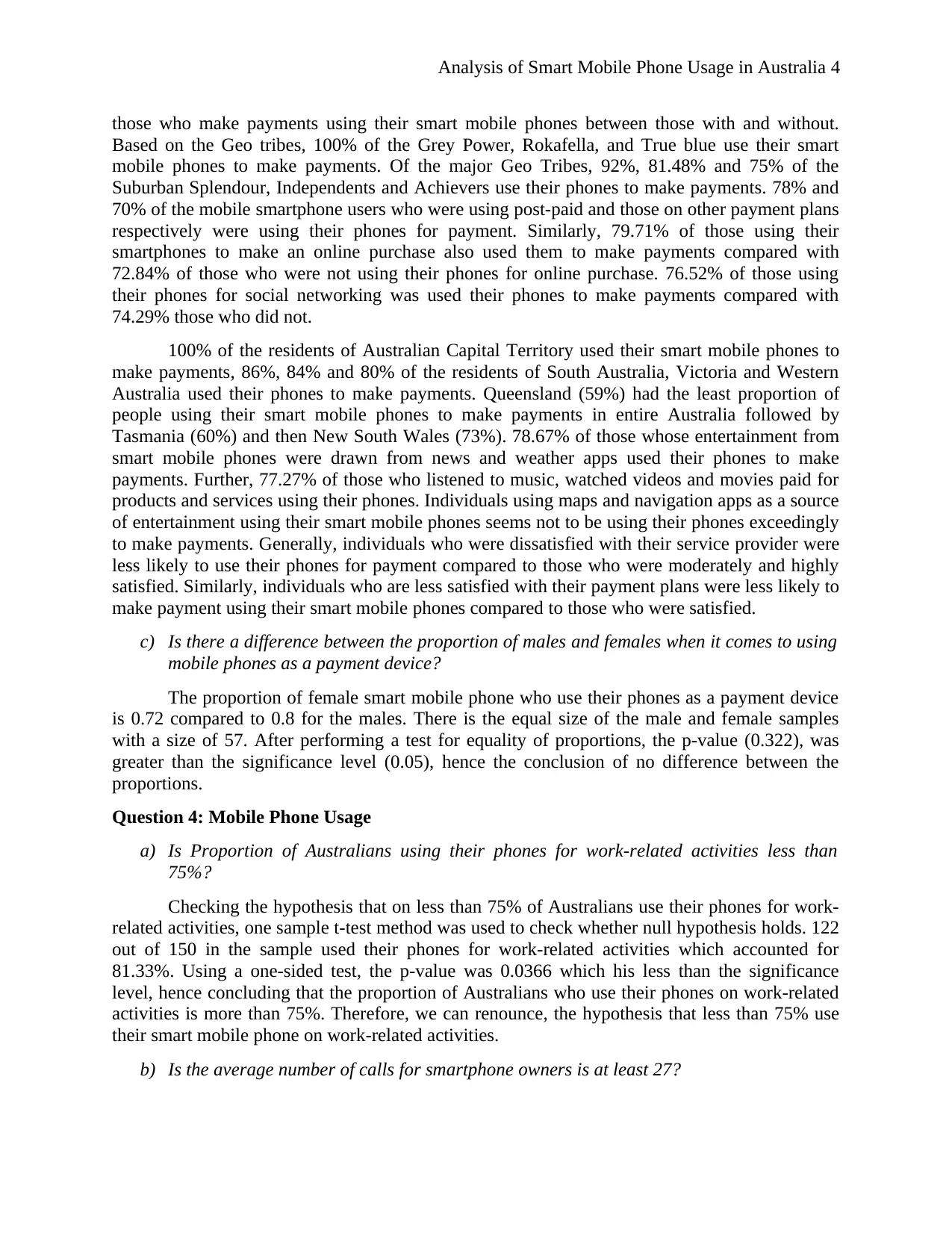
Analysis of Smart Mobile Phone Usage in Australia 4
those who make payments using their smart mobile phones between those with and without.
Based on the Geo tribes, 100% of the Grey Power, Rokafella, and True blue use their smart
mobile phones to make payments. Of the major Geo Tribes, 92%, 81.48% and 75% of the
Suburban Splendour, Independents and Achievers use their phones to make payments. 78% and
70% of the mobile smartphone users who were using post-paid and those on other payment plans
respectively were using their phones for payment. Similarly, 79.71% of those using their
smartphones to make an online purchase also used them to make payments compared with
72.84% of those who were not using their phones for online purchase. 76.52% of those using
their phones for social networking was used their phones to make payments compared with
74.29% those who did not.
100% of the residents of Australian Capital Territory used their smart mobile phones to
make payments, 86%, 84% and 80% of the residents of South Australia, Victoria and Western
Australia used their phones to make payments. Queensland (59%) had the least proportion of
people using their smart mobile phones to make payments in entire Australia followed by
Tasmania (60%) and then New South Wales (73%). 78.67% of those whose entertainment from
smart mobile phones were drawn from news and weather apps used their phones to make
payments. Further, 77.27% of those who listened to music, watched videos and movies paid for
products and services using their phones. Individuals using maps and navigation apps as a source
of entertainment using their smart mobile phones seems not to be using their phones exceedingly
to make payments. Generally, individuals who were dissatisfied with their service provider were
less likely to use their phones for payment compared to those who were moderately and highly
satisfied. Similarly, individuals who are less satisfied with their payment plans were less likely to
make payment using their smart mobile phones compared to those who were satisfied.
c) Is there a difference between the proportion of males and females when it comes to using
mobile phones as a payment device?
The proportion of female smart mobile phone who use their phones as a payment device
is 0.72 compared to 0.8 for the males. There is the equal size of the male and female samples
with a size of 57. After performing a test for equality of proportions, the p-value (0.322), was
greater than the significance level (0.05), hence the conclusion of no difference between the
proportions.
Question 4: Mobile Phone Usage
a) Is Proportion of Australians using their phones for work-related activities less than
75%?
Checking the hypothesis that on less than 75% of Australians use their phones for work-
related activities, one sample t-test method was used to check whether null hypothesis holds. 122
out of 150 in the sample used their phones for work-related activities which accounted for
81.33%. Using a one-sided test, the p-value was 0.0366 which his less than the significance
level, hence concluding that the proportion of Australians who use their phones on work-related
activities is more than 75%. Therefore, we can renounce, the hypothesis that less than 75% use
their smart mobile phone on work-related activities.
b) Is the average number of calls for smartphone owners is at least 27?
those who make payments using their smart mobile phones between those with and without.
Based on the Geo tribes, 100% of the Grey Power, Rokafella, and True blue use their smart
mobile phones to make payments. Of the major Geo Tribes, 92%, 81.48% and 75% of the
Suburban Splendour, Independents and Achievers use their phones to make payments. 78% and
70% of the mobile smartphone users who were using post-paid and those on other payment plans
respectively were using their phones for payment. Similarly, 79.71% of those using their
smartphones to make an online purchase also used them to make payments compared with
72.84% of those who were not using their phones for online purchase. 76.52% of those using
their phones for social networking was used their phones to make payments compared with
74.29% those who did not.
100% of the residents of Australian Capital Territory used their smart mobile phones to
make payments, 86%, 84% and 80% of the residents of South Australia, Victoria and Western
Australia used their phones to make payments. Queensland (59%) had the least proportion of
people using their smart mobile phones to make payments in entire Australia followed by
Tasmania (60%) and then New South Wales (73%). 78.67% of those whose entertainment from
smart mobile phones were drawn from news and weather apps used their phones to make
payments. Further, 77.27% of those who listened to music, watched videos and movies paid for
products and services using their phones. Individuals using maps and navigation apps as a source
of entertainment using their smart mobile phones seems not to be using their phones exceedingly
to make payments. Generally, individuals who were dissatisfied with their service provider were
less likely to use their phones for payment compared to those who were moderately and highly
satisfied. Similarly, individuals who are less satisfied with their payment plans were less likely to
make payment using their smart mobile phones compared to those who were satisfied.
c) Is there a difference between the proportion of males and females when it comes to using
mobile phones as a payment device?
The proportion of female smart mobile phone who use their phones as a payment device
is 0.72 compared to 0.8 for the males. There is the equal size of the male and female samples
with a size of 57. After performing a test for equality of proportions, the p-value (0.322), was
greater than the significance level (0.05), hence the conclusion of no difference between the
proportions.
Question 4: Mobile Phone Usage
a) Is Proportion of Australians using their phones for work-related activities less than
75%?
Checking the hypothesis that on less than 75% of Australians use their phones for work-
related activities, one sample t-test method was used to check whether null hypothesis holds. 122
out of 150 in the sample used their phones for work-related activities which accounted for
81.33%. Using a one-sided test, the p-value was 0.0366 which his less than the significance
level, hence concluding that the proportion of Australians who use their phones on work-related
activities is more than 75%. Therefore, we can renounce, the hypothesis that less than 75% use
their smart mobile phone on work-related activities.
b) Is the average number of calls for smartphone owners is at least 27?
Paraphrase This Document
Need a fresh take? Get an instant paraphrase of this document with our AI Paraphraser
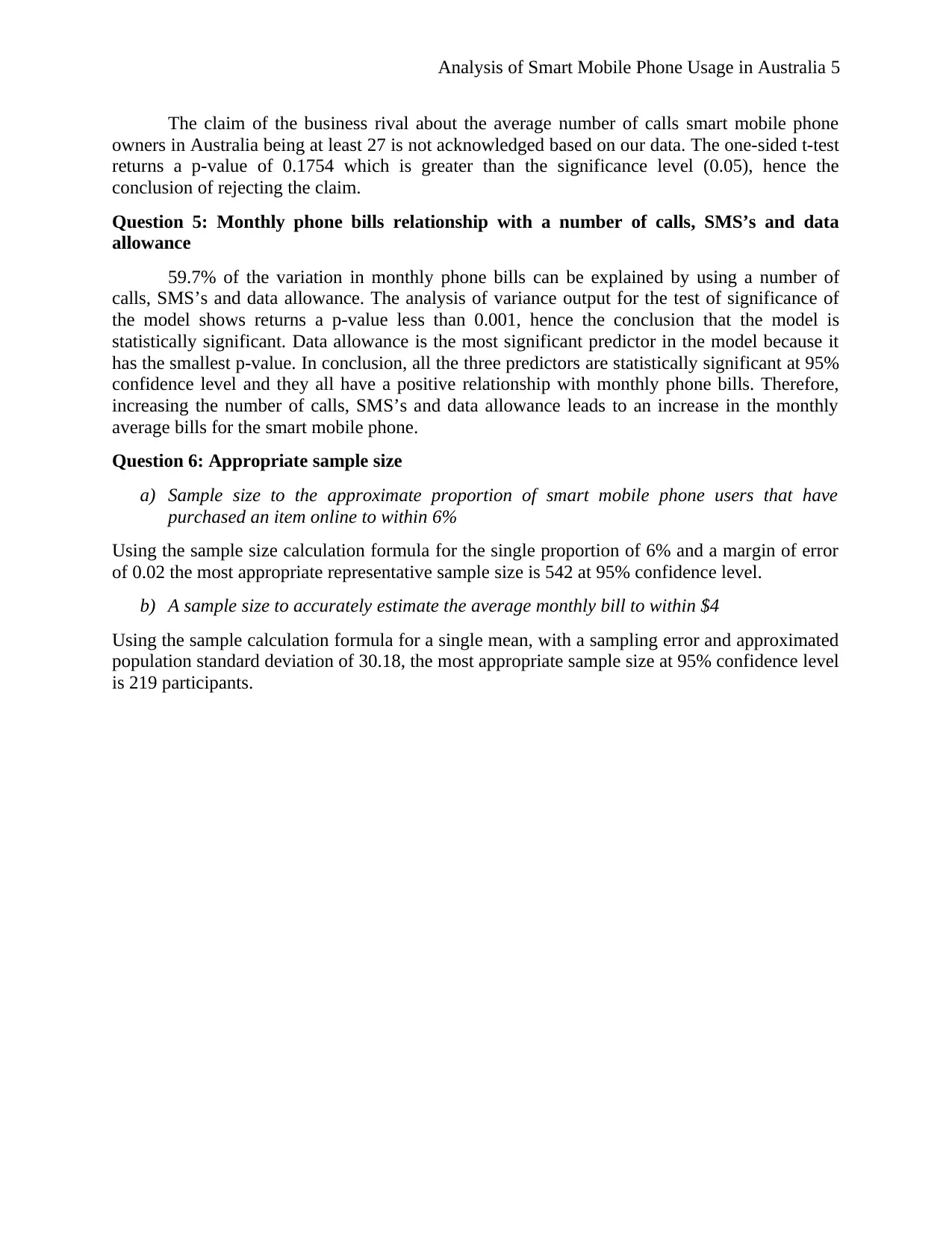
Analysis of Smart Mobile Phone Usage in Australia 5
The claim of the business rival about the average number of calls smart mobile phone
owners in Australia being at least 27 is not acknowledged based on our data. The one-sided t-test
returns a p-value of 0.1754 which is greater than the significance level (0.05), hence the
conclusion of rejecting the claim.
Question 5: Monthly phone bills relationship with a number of calls, SMS’s and data
allowance
59.7% of the variation in monthly phone bills can be explained by using a number of
calls, SMS’s and data allowance. The analysis of variance output for the test of significance of
the model shows returns a p-value less than 0.001, hence the conclusion that the model is
statistically significant. Data allowance is the most significant predictor in the model because it
has the smallest p-value. In conclusion, all the three predictors are statistically significant at 95%
confidence level and they all have a positive relationship with monthly phone bills. Therefore,
increasing the number of calls, SMS’s and data allowance leads to an increase in the monthly
average bills for the smart mobile phone.
Question 6: Appropriate sample size
a) Sample size to the approximate proportion of smart mobile phone users that have
purchased an item online to within 6%
Using the sample size calculation formula for the single proportion of 6% and a margin of error
of 0.02 the most appropriate representative sample size is 542 at 95% confidence level.
b) A sample size to accurately estimate the average monthly bill to within $4
Using the sample calculation formula for a single mean, with a sampling error and approximated
population standard deviation of 30.18, the most appropriate sample size at 95% confidence level
is 219 participants.
The claim of the business rival about the average number of calls smart mobile phone
owners in Australia being at least 27 is not acknowledged based on our data. The one-sided t-test
returns a p-value of 0.1754 which is greater than the significance level (0.05), hence the
conclusion of rejecting the claim.
Question 5: Monthly phone bills relationship with a number of calls, SMS’s and data
allowance
59.7% of the variation in monthly phone bills can be explained by using a number of
calls, SMS’s and data allowance. The analysis of variance output for the test of significance of
the model shows returns a p-value less than 0.001, hence the conclusion that the model is
statistically significant. Data allowance is the most significant predictor in the model because it
has the smallest p-value. In conclusion, all the three predictors are statistically significant at 95%
confidence level and they all have a positive relationship with monthly phone bills. Therefore,
increasing the number of calls, SMS’s and data allowance leads to an increase in the monthly
average bills for the smart mobile phone.
Question 6: Appropriate sample size
a) Sample size to the approximate proportion of smart mobile phone users that have
purchased an item online to within 6%
Using the sample size calculation formula for the single proportion of 6% and a margin of error
of 0.02 the most appropriate representative sample size is 542 at 95% confidence level.
b) A sample size to accurately estimate the average monthly bill to within $4
Using the sample calculation formula for a single mean, with a sampling error and approximated
population standard deviation of 30.18, the most appropriate sample size at 95% confidence level
is 219 participants.
1 out of 5
Your All-in-One AI-Powered Toolkit for Academic Success.
+13062052269
info@desklib.com
Available 24*7 on WhatsApp / Email
![[object Object]](/_next/static/media/star-bottom.7253800d.svg)
Unlock your academic potential
Copyright © 2020–2025 A2Z Services. All Rights Reserved. Developed and managed by ZUCOL.


